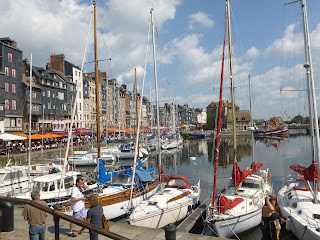 |
| Joan of Arc statue |
 |
| Reim's Notre Dame |
On our way to the north coast of France, we stopped in Reims for a couple of days. The city's Cathedral of Notre Dame is to France what Westminster Abbey is to England. Begun in 1211, the cathedral was the site of the coronation of French kings until 1825; most notably the crowning of Charles VII In 1429 with Joan of Arc at his side. The teenage girl led the French Army to several victories during the Hundred Years' War. She was responsible for freeing Reims from the English enabling Charles to be crowned king. Unfortunately, France did not return the favor and free her from the English who burned Joan at the stake in 1431. She was 19.
Our first stop on the north coast was the charming French
resort of Le Touquet. Created in 1876 by the owner of the Paris newspaper, the town became known as 'Paris By The Sea.' Being in such close proximity to England, it also attracts the Brits. In days gone by, Noel Coward and the so-called 'smart set' spent weekends here.
Continuing west along the coast, we spent a few days at Etretat. The charming little town is nestled between two towering cliffs, both of which we climbed (376 steps up one) and hiked along. Between the two cliffs, a small beach curves around clear water.
The white, limestone cliffs share the same geological origins as the white cliffs of Dover on the other side of the English Channel (think Charles Dickens and David Copperfield). Interesting, natural archways jut out into the sea drawing the attention of many artists including Claude Monet who painted here in the late 1800s.
At the mouth of the Seine River sits the quaint town of Honfleur, our next stop. Originally a strategic defense port, it now attracts tourists as well as sailors and fishermen. Flemish buildings and cobblestone streets surround the Vieux Bassin - the old port. Popular sites in Honfleur include St. Catherine's Church, the largest wooden church in France. The bell tower had to be built separately because the church could not support the weight of the bells. It was from Honfleur that Samuel Champlain returned to the New World to establish French settlements on Canada's St.Lawrence River. He is credited with founding Quebec in 1608.
It seems that the entire population of France is on vacation during the month of August. Seeking a brief respite from the crowds we traveled slightly inland to the city of St. Lo for a couple of days. Our hotel was situated on the River Vire and across from the ancient ramparts that were originally built to defend against invading Norsemen. The Church of Notre Dame sits in the center of the old town. Partially destroyed during World War II, it was reconstructed by blending modern architecture with the old.
A particularly charming aspect of St. Lo is the abundance of colorful flowers. No boring, cement roundabouts here. The circles overflow with brilliant colors and varieties of flowers.
Now it is on to Brittany.
TRAVEL TIP: Mercure is a chain of reliable 3 and 4 star hotels throughout Europe. A nice perk they offer is free breakfast for people over 60.
Our first stop on the north coast was the charming French
 |
| Etretat looking west |
 |
| Looking east from our hotel on the cliff in Etretat |
 |
| Monet painting of Etretat |
 |
| The Elephant Arch Etretat |
The white, limestone cliffs share the same geological origins as the white cliffs of Dover on the other side of the English Channel (think Charles Dickens and David Copperfield). Interesting, natural archways jut out into the sea drawing the attention of many artists including Claude Monet who painted here in the late 1800s.
 |
| St. Catherine Bell Tower Honfleur |
 |
| Le Vieux Bassin (Old Port) of Honfleur |
 |
Honfleur: Many old buildings have been converted to museums. |
It seems that the entire population of France is on vacation during the month of August. Seeking a brief respite from the crowds we traveled slightly inland to the city of St. Lo for a couple of days. Our hotel was situated on the River Vire and across from the ancient ramparts that were originally built to defend against invading Norsemen. The Church of Notre Dame sits in the center of the old town. Partially destroyed during World War II, it was reconstructed by blending modern architecture with the old.
 |
| St. Lo church with pre-war and post-war construction |
 |
| Entrance walls of St. Lo's fortification |
A particularly charming aspect of St. Lo is the abundance of colorful flowers. No boring, cement roundabouts here. The circles overflow with brilliant colors and varieties of flowers.
 |
| The River Vire runs through St. Lo |
TRAVEL TIP: Mercure is a chain of reliable 3 and 4 star hotels throughout Europe. A nice perk they offer is free breakfast for people over 60.
No comments:
Post a Comment